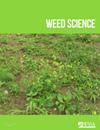Discrimination of Morningglory Species (Ipomoea spp.) Using Near-Infrared Spectroscopy and Multivariate Analysis
IF 2.1
2区 农林科学
Q2 AGRONOMY
引用次数: 1
Abstract
Abstract The occurrence of weeds is one of the main factors limiting agricultural productivity. Studies on new techniques for the identification of these species can contribute to the development of proximal sensors, which in the future might be coupled to machines to optimize the performance of species-specific weed management. Thus, the objective of this study was to use near-infrared (NIR) spectroscopy and multivariate analysis to discriminate three morningglory species (Ipomoea spp.). The NIR spectra were collected from the leaves of the three weed species at the vegetative stage (up to five leaves), within the spectral band of 4,000 to 10,000 cm–1. The discrimination models were selected according to accuracy, sensitivity, specificity, and Youden's index and were analyzed with a validation data set (n = 135). The best results occurred when the selection of spectral bands associated with the use of preprocessing was performed. It was possible to obtain an accuracy of 99.3%, 98.5%, and 98.7% for ivyleaf morningglory (Ipomoea hederifolia L.), Japanese morningglory [Ipomoea nil (L.) Roth], and hairy woodrose [Merremia aegyptia (L.) Urb.], respectively. NIR spectroscopy associated with principal component analysis and linear discriminant analysis (PC-LDA) or partial least-squares regression with discriminant analysis (PLS-DA) can be used to discriminate Ipomoea spp.晨光属植物近红外光谱及多变量分析鉴别
摘要杂草的发生是制约农业生产力的主要因素之一。对识别这些物种的新技术的研究有助于开发近端传感器,未来可能将其与机器相结合,以优化特定物种杂草管理的性能。因此,本研究的目的是使用近红外(NIR)光谱和多元分析来区分三种牵牛花(Ipomoea spp.)。近红外光谱是从三种处于营养期的杂草(最多五片叶子)的叶子上收集的,在4000至10000 cm-1的光谱带内。根据准确性、敏感性、特异性和Youden指数选择判别模型,并使用验证数据集(n=135)进行分析。当进行与预处理的使用相关的光谱带的选择时,出现了最佳结果。ivyleaf牵牛花(Ipomoea hederifolia L.)、日本牵牛花[Ipomea nil(L.)Roth]和毛木玫瑰[Merimia aegyptia(L.)Urb.]的准确率分别为99.3%、98.5%和98.7%。与主成分分析和线性判别分析(PC-LDA)或偏最小二乘回归和判别分析(PLS-DA)相关联的近红外光谱可用于区分Ipomoea spp。
本文章由计算机程序翻译,如有差异,请以英文原文为准。
求助全文
约1分钟内获得全文
求助全文
来源期刊

Weed Science
农林科学-农艺学
CiteScore
4.60
自引率
12.00%
发文量
64
审稿时长
12-24 weeks
期刊介绍:
Weed Science publishes original research and scholarship in the form of peer-reviewed articles focused on fundamental research directly related to all aspects of weed science in agricultural systems. Topics for Weed Science include:
- the biology and ecology of weeds in agricultural, forestry, aquatic, turf, recreational, rights-of-way and other settings, genetics of weeds
- herbicide resistance, chemistry, biochemistry, physiology and molecular action of herbicides and plant growth regulators used to manage undesirable vegetation
- ecology of cropping and other agricultural systems as they relate to weed management
- biological and ecological aspects of weed control tools including biological agents, and herbicide resistant crops
- effect of weed management on soil, air and water.
 求助内容:
求助内容: 应助结果提醒方式:
应助结果提醒方式:


